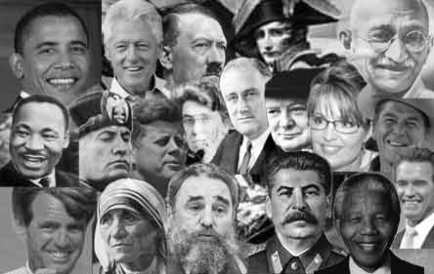1. What Have you Learned about Leadership Theory?
Over the past few weeks I have learned a lot about different leadership theories. The one that has stuck with me the most is behavioral theory and how leaders can be made not born. After doing research on this theory, I finally realized that I too can be a leader, and great one. I always thought that some people are just born to be leaders and that was it. There was no hope for those of us who just didn’t have those natural leadership qualities. I am completely wrong. Or, that is at least how I feel. Leaders can be made through experiences, developing themselves, and learning from others what it takes to be a good leader. Their behavior and the way they act reflects the type of leaders they are.
2. Make connections between your perspective on leadership now and the Kaleidoscope class in terms of leadership theory.
The Kaleidoscope and leadership theories go hand in hand. In order to be a good leader, you need to understand yourself, and what you value. It is important to understand this before you can move on and help others or lead them. The Kaleidoscope also emphasizes on being people savvy, which is another important aspect. Leaders need to be able to identify with those they are leading, and have a good understanding of how to communicate with them.
3. Review your leadership map – how do you fit these pieces together.
My leadership map would consist of the leader and how they are able to learn from other individuals and their own experiences. The more experience you have being a leader, the better at it you will become. My map would also point out that everyone is capable of being a leader, and I would give examples of how they can achieve that. Just because you may not be in the spotlight, you can be a leader.
4. Explore your classmates blogs as well as other leadership theorists/practitioners blogs to get some ideas for how you might want to convey what you think about leadership theory?
My favorite blogs are the ones that tell stories and example of different leadership experiences. I also like when I read about people’s mistakes, and how they learned from it. There are many influential people out there. Experiences that people write about seem to be easier to connect too, and I am able to connect with them more.
5. What do you want to convey about leadership? What have you learned?
The most important thing I want to convey is that all leaders are not born, you can be made into a leader. I always thought it was intimidating to be a leader, but now I realize that there are different types of leaders, and leadership styles, that fit different people. I also want to convey that leaders are human, and its ok to make mistakes. I think the best leaders are those that take risks, and want to make changes for the better. It is important to realize you may fail, but to pick the pieces back up and try again.
6. What potential contexts might you be needing to convey your leadership perspective? Who is the audience, what is the setting, what would you want to hear from them?
The audience I would be talking to would be college students, maybe those who are about to step into the real world and have to take on leadership roles. It can be an intimidating time in someone’s life, and I am realizing that first hand. Although you may not have the confidence to take on that particular role, if you have the motivation and commitment you will succeed. I think its important for us college graduates to want to take risks, and I want them to know that.
7.What are you values? How do/did your values shape your thinking on leadership?
My values are loyalty, committment and responsibility. I have always felt that in order to gain the trust of those around you, you have to be loyal. Which goes the same way as you gain the trust of other people by their loyalty to you. I know in my experiences, that I hold myself accountable and want people to trust me, so I expect that from others as well. I also feel that I am always committed to what I am doing. Whether it is in school, at work, or in my personal life, I take on a project and try my hardest to give my best. I am committed to the work that I am involved in. I also feel that responsibility is an important value of mine. I always take responsibility of my actions, and want others to do the same. I do not like when people blame others for things that are not done, or done the wrong way. I think people need to take responsibility if they do not know they answers, and ask questions.
8.Given your integration of theory, self, and potential contexts, think about a narrative approach. Where are you? What are you wearing? What is the treatment?
I would probably be in a typical classroom, or inviting environment that is comfortable. I want people to be able to put themselves in my position and be able to relate. Sometimes it is intimidating when you see someone all dressed up, looking perfectly done up and in a business setting. I would like a more casual feel. For me personally, it is easier to connect with the speaker when I feel I can see myself in their shoes.
9.List 2-3 story ideas – each about 60 seconds that could potentially be used.
1.Example of leadership that shaped your thinking: An example of leadership that got me thinking about how people may not be born leaders is the story of Steve Jobs. First of all, he was a college drop out. Most people probably wouldn’t think of him as a leader because of this. Many leaders seem to fit a certain criteria, or persona. But I believe that Steve Jobs was different. He was able to challenge himself, and become one of the greatest leaders of our time. It makes me realize that anyone is capable of being a good leader, no matter your background. It is the steps you take in your life and what you learn along the way to achieve greatness.
2. Role model/leader that shaped your thinking: I think the most influential person for me right now is my current General Manager. I like the way he approaches things and leads our two hotels. He is very open to teaching people and letting them take on tasks they are interested in. His type of leadership style works for our group. He helps guide us in the right direction, but also lets us have the freedom to make the choices with think are appropriate.
10. Consider what a 4 minute video of a narrative about your leadership perspective might look like:
My video would consist of me talking to a group of students on how its ok to feel that you are not a leader, or have the natural ability to be a leader. It would be talking about how you can learn from your challenges, mistakes, and taking risks. There is no secret potion that is going to make you a leader. It is going to be your dedication and commitment to wanting to become a great leader. My video would be informative, trying to relate to my audience so they feel more at ease when they transfer from college to the real world.





